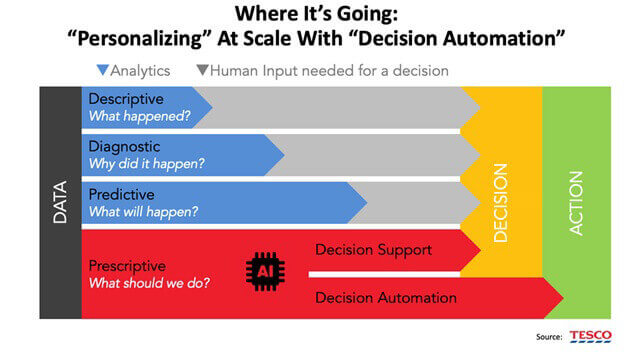RBTE 2017: B&Q Enhances DIY With Digital
B&Q, the UK’s #1 home improvement retailer, like its American counterparts Home Depot and Lowes, has a challenge. The “warehouse ” concept for DIY products is certainly not convenient for time starved consumers (a casual browse through various social media threads will attest to that: “I can’t brave the B&Q car park and only want one item “). B&Q and its kind aren’t alone; the challenges for DIY and other retailers today are created by consumers’ digitally enabled shopping behaviors.
Since 2015, when B&Q (part of the Kingfisher PLC group) announced closing over 50 stores, the retailer has seen an improved outlook. A part of that has to do with Kingfisher’s determination to push ahead with an ¬£800m overhaul of the business in 2015. As recently as September 2016, Kingfisher’s CEO V√©ronique Laury promised to “significantly increase ” the pace of that overhaul by reviewing product assortments, updating technology, and improving the supply chain. Undoubtedly, a component of that overhaul includes modernizing the shopping experience to enable consumers’ digitally enabled shopping behaviors.
At the Retail Technology & Business Exposition (RBTE) in London UK last week, B&Q’s head of Digital Experience Kirsten Taylor Groves told the story of how the retailer is bringing “digital ” to both consumers’ paths to purchase and to the employee experience. Kirsten stated the case for change with hard data: the company surveyed consumers and found that 52% use mobile in-store to find products, 12% look up product information, and 6% access “how to ” information. After experimenting with ideas such as in-store order points, in-aisle messaging, and enhanced self-service technologies, B&Q articulated “three pillars ” of the digital selling environment: assisted selling, consumer mobile enablement, and a digitally enhanced shopping experience.
Needs-based Paths-to-purchase
A key to getting “digital enablement ” right is in understanding consumers’ several paths to purchase based on the need they are fulfilling, according to Kirsten. The speaker shared a graph showing how B&Q defines the steps in the path-to-purchase, the types of customer needs being fulfilled, and which steps in the path to purchase can be enhanced with digital touchpoints (chart reproduced below, from my notes):

According to the retailer, the digital touchpoints along those paths are enabled at B&Q by “a single content authority ” where content is created once but available to display via any number of user interfaces, “enterprise retail services ” for product, price, inventory, fulfillment, customer, order, and payment, and finally, several “delivery options ” available to the consumer. Kirsten stated that to achieve this, B&Q “swapped out all legacy backend systems “.
The digital touchpoints include employee assisted selling devices that all share a consistent customer view and content, and a single payment process. Consumer mobile functionality is also important, with “context aware ” features that replace costly in-aisle kiosks. In-store digital experiences also create “immersive relationships “, for example, digital kitchen designs.
When it comes to fulfillment, the speaker had more hard data: 66% of B&Q’s shoppers use “click & collect “, and 30% of those buy additional items while in the store. According to Kirsten, that means that for every click & collect purchase, about ¬Ω of the items in the basket are picked by the store and the other half is added at the store by the customer. With those kinds of results, it’s no surprise that the click & collect desk is a destination at each of the retailer’s almost 300 stores.
Key Learnings
RSR has for years recommended to retailers that in order to harmonize the digital and physical shopping environments into one “omnichannel” shopping experience, it is critical that retailers first envision what the path-to-purchase should be. So it was really refreshing to hear how B&Q has gone about the task of designing the shopping experience. Beyond that, Kirsten shared some keys learnings for all retailers to consider:
- 1.There needs to be a single view of inventory across the enterprise;
- 2.Design the software to be “build once/used many “;
- 3.Assisted selling is key to a differentiating customer experience;
- 4.Enable customer owned devices with content and features;
- 5.Offer the full range of items across the entire “omnichannel” selling environment;
- 6.Offer click & collect;
- 7.Promote a culture and mindset that encourages omnichannel selling. For example, Kirsten said that B&Q allocates all eCommerce sales to the stores, eliminating the possibility of friction over who gets credit for particular sales;
- 8.Well defined policies and store-level training are important to making this a success.
Final Thoughts
Since the rise of the “omnichannel” concept beginning in 2010, retailers focused first on how to engage with consumers in the digital realm, and then how to enable multiple fulfillment options. Now the focus across the entire industry is on bringing the store into the equation. B&Q is a leader when it comes to making it all come together. The B&Q story is a good one, and other retailers should seriously consider the practical advice that Kirsten Taylor Groves shared at the RBTE 2017 session.
